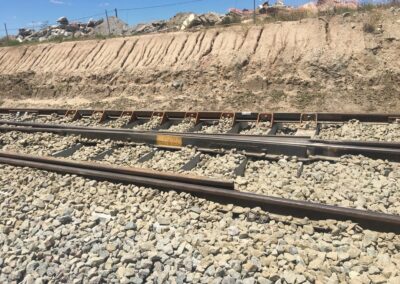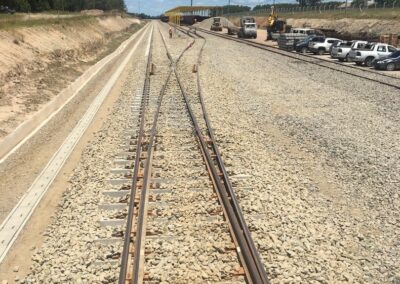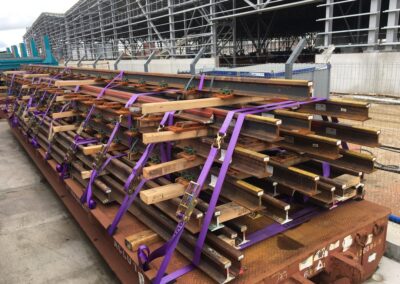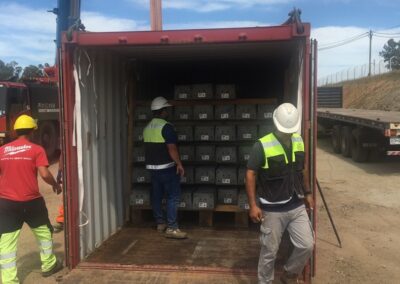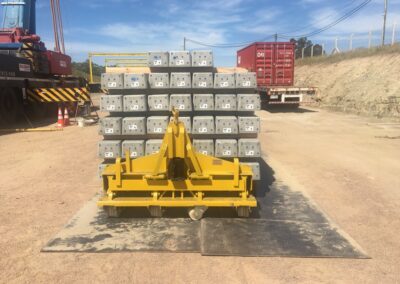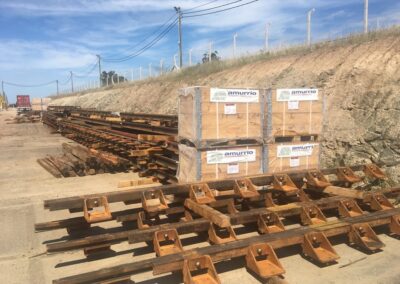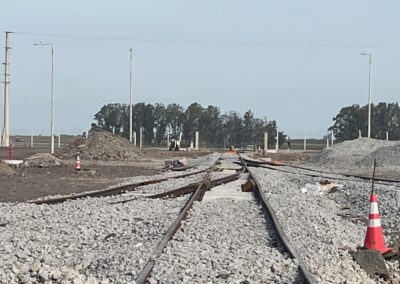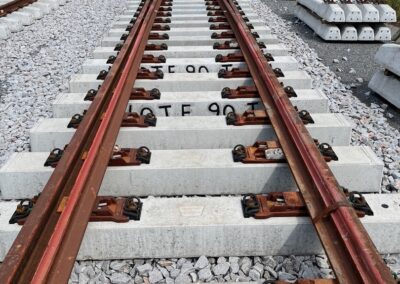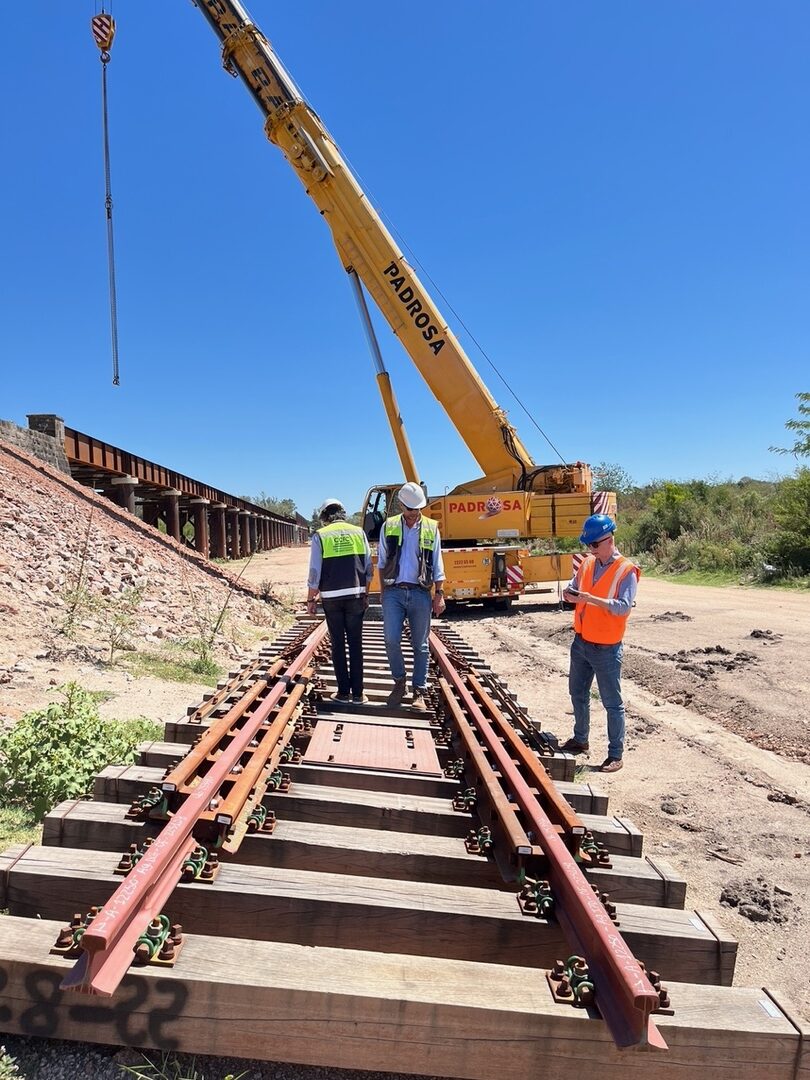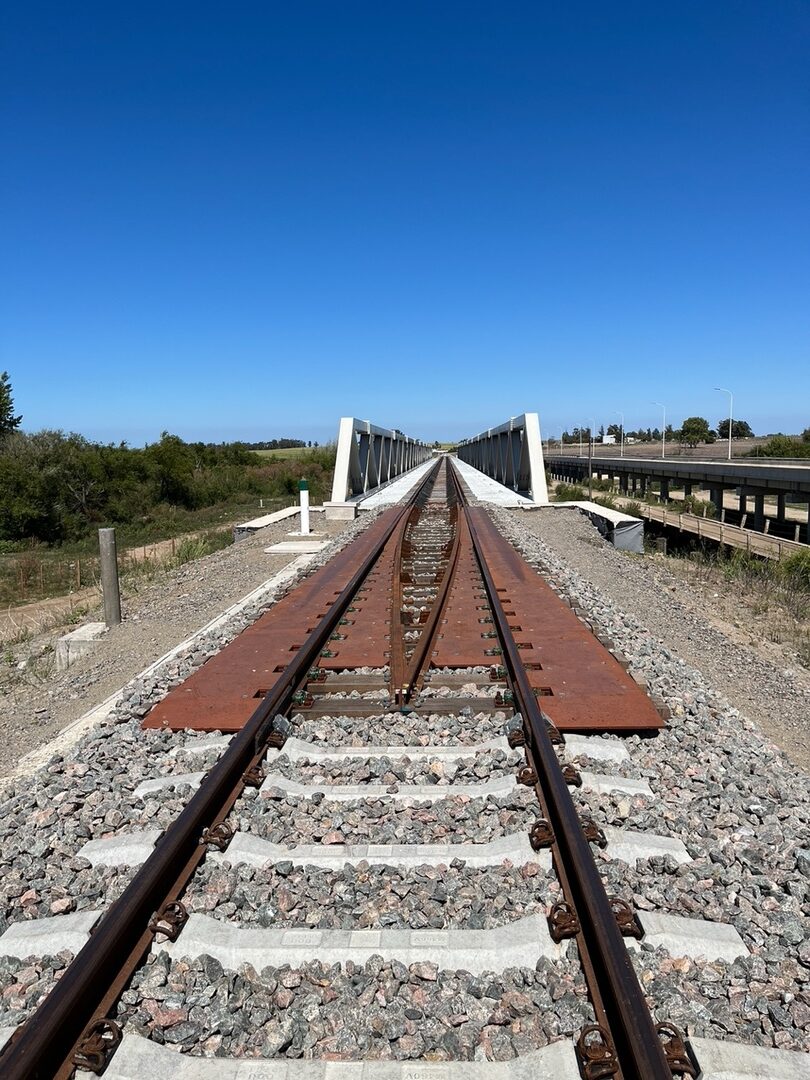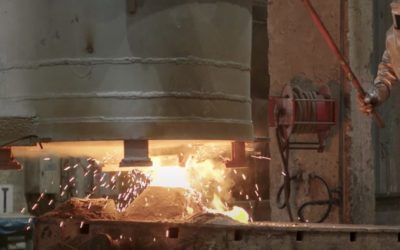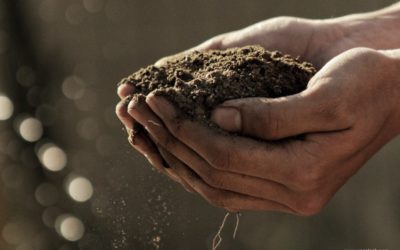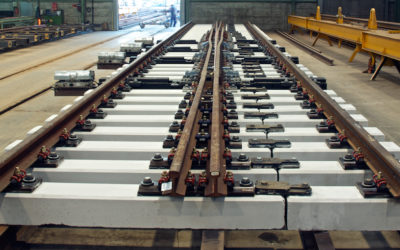THE PROJECT NUMBERS:
MONTHS OF WORK
CONVENTIONAL TYPE TURNOUTS
RE-RAILERS
TRACK EXPANSION DEVICES
WEEK TECHNICAL ASSISTANCE
Ferrocarril Central is a strategically important rail infrastructure project promoted by the Uruguayan government to address the complete reconstruction of the rail line linking the port of Montevideo with the town of Paso de los Toros in the interior of the country.
The main objective of this project is to provide a route to the sea for the pulp manufactured at the new plant of the Finnish forestry company UPM-Kymmene, the company’s second plant in the country.
Over the course of 13 months of work, Amurrio Ferrocarril y Equipos supplied the Consorcio Constructor Ferrocarril Central (CCFC), the winning bidder for the project, with a total of 124 conventional turnouts, 20 derailers and 5 expansion devices, and provided technical assistance in their installation.
It has been a huge challenge of production, logistics and collaboration on both sides of the Atlantic Ocean that has been successfully met, and which Rafael Crespo, Amurrio’s correspondent in Uruguay, and Jean Robert Laarhoven, international sales manager of the European company, are now talking about during a videoconference.

Question: What is the context of this project?
Rafael Crespo: The Central Railway project starts back in 2017, as a result of the government agreeing to the installation in the country of the second plant of the Finnish cellulose manufacturing company UPM. This company has already had a plant on the Uruguayan west coast for about 20 years.
In 2015 it negotiated to install a second plant in Uruguay; once the location was defined, in Centenario (Department of Durazno), one of the requirements for UPM to make the investment is to ask the government for a transport route to take the plant’s production to the port of Montevideo. After defining the contracts, the government began the bidding process to renew the existing route. It was a very old track, in which some very small sections had been renewed, and which supported only 18 tons per axle, with wooden sleepers and rigid fastening. The new track supports up to 22.5 tons per axle at a speed of 80 km/h.
It is agreed to make a complete renovation of the layout, to suit the needs of the project. Thus, in 2018, the tender documents start to be drawn up in accordance with European regulations.
At the beginning there were many companies interested in the tender, there was talk of up to ten candidates. Finally, when the time came to open the tenders there were three bids. The first was from a consortium of Chinese companies, CMEC and SHDC; the second was from Acciona; and the third was from Grupo Vía Central, made up of the Uruguayan companies Saceem and Berkes, the Spanish company Sacyr and the French company TSO/NGE.
Question: How did Amurrio come into contact with this project?
Rafael Crespo: Amurrio worked long before the bidding process to participate in this project. We submitted our bids to six or eight companies. We were working at least since 2017, visiting the companies that participated in the data rooms organized by the government. And with an important advantage: Amurrio was the only turnout manufacturer with European technology with a local presence in Uruguay, where we have been working since 2005.
After the award, in 2019 negotiations began with CCFC (Grupo Vía Central), which was the one that won the tender, and we reached the award of 124 track devices.
This was the first time that, at the railway level, there were buyers that were not in Uruguay, such as Sacyr, which used the structure of its parent company to make many of the purchases that were finalized for Uruguay. In this sense, the work from the Amurrio headquarters was crucial to close the sales.
Jean Robert Laarhoven: I believe that it would not have been completed without the teamwork that was carried out. The local presence has been fundamental, which is something we always bet on from Amurrio, and in this specific case, it has been a very demanding process both at a commercial and technical level. The preparation of the offer, and also the pursuit of the customer, being present and very aware of what is happening on the ground in the country, is key. It is true that the parent companies participated and were very involved, but in the end the project is there, in Uruguay. All the preparation of the contract conditions, of understanding well what they said, what the client needs, all that required many hours of meetings between us, which were very important.
Puntualizando esto, yo creo que no se habría cerrado sin el trabajo en equipo que se llevó a cabo. Ha sido fundamental la presencia local, que es algo por lo que apostamos siempre desde Amurrio, y en este caso concreto, que ha sido un proceso muy exigente tanto a nivel comercial como a nivel técnico. La preparación de la oferta, y también lo que es perseguir al cliente, estar presente y muy pendiente de lo que sucede sobre el terreno en el país, es clave. Porque es verdad que las casas matrices participaron y estuvieron muy implicadas, pero al final el proyecto está allí, en Uruguay. Toda la preparación de las condiciones del contrato, de entender bien lo que decían, lo que necesita el cliente, todo eso requirió muchas horas de reuniones entre nosotros que fueron muy importantes.
Rafael Crespo: One of the keys to success was the teamwork between the local presence in Uruguay, the close follow-up and the work from the head office in Spain.
Question: What were the start and end dates of the project?
Rafael Crespo: We started the supply in November 2020 and finished in December 2021. One year’s supply for 124 track devices. One of the great challenges of the project was to carry it out within one year.
QUESTION: What were the greatest difficulties encountered?
Rafael Crespo: Undoubtedly it was the whole issue of production and all the logistics of producing this volume of material in such a limited time. It should be noted that the project helped us a little bit, due to delays it suffered, it was supposed to be finished in September 2022, and it will be finished in December 2023. And yet it has been quite a challenge. We all had a great lesson with the logistics, we learned a lot.
Jean Robert Laarhoven: We can say that it was a great success. We were sending the metallic material from Amurrio, after having checked the assemblies with the sleepers, or sleepers, as they say there.
The sleepers were manufactured in Portugal, and left in separate shipments. Squaring these logistics, in which the metal components were shipped from the port of Bilbao and the sleepers were shipped from Portugal, was an interesting challenge. In addition, departures on different ships and with different loading methods – containers for the sleepers, wheeled platforms for the metal part – so that they would arrive at the same time, was the challenge to overcome.
It should also be noted that the customer received and stored the materials very correctly, and we had very fluid information that allowed us to quickly solve the few incidents that occurred, including in the next shipment the spare parts for the defective material. But in any case, the incidents were small and really the exception to the rule … a few plates and little else, and quickly in the next shipment could be replaced.
Rafael Crespo: In total we made nine shipments from the port of Bilbao and nine from Portugal.
And of course there was a major challenge for Amurrio in production. It was the first time we faced a challenge of these characteristics, in terms of volume and delivery time, and at a distance of 10,000 kilometers. And everything worked out wonderfully; not a single complaint came from the customer. The scheduling was very precisely adhered to.
Jean Robert Laarhoven:
Another challenge was the start of production, but that’s like any other project. When you start up, the beginning is always the hardest part, fixing the little problems, adjusting to the deadline of the first delivery, that was quite complex. But once we started shooting, we didn’t have any major problems. So I think the biggest challenge was the logistics, as we have already mentioned. And then the additional things that the customer asked us for, such as technical assistance, or the supply of locks for the turnouts. That was almost more complicated than the original supply.
As for the technical assistance, the constant presence is also important. When we were not there, Rafael would talk to the foreman, to the buyer, to whoever was needed to keep the contact fresh. So when we sent people there, the contacts already existed, and the entry of our personnel was much easier. In this case, we sent a specialist for a week, who is also in charge of assembly in the factory. Someone who had already worked with this material and knew perfectly well how to lead teams and teach them how to install the equipment. It was a complete coaching, because we had to finish some drilling, measuring and adjustment operations… these were operations that the customer did not hire us for at the time, but which were needed in the end. The customer was very sensible and asked us for the service, which allowed us to solve some incidents smoothly.
Question: What is the current status of the project?
Rafael Crespo: I would say that it is 90-95% finished. The remaining 5 or 10%, which is currently being worked on, is the most complicated because it is the entrance to Montevideo. It is where the bottleneck is, with many technical and urban planning issues, expropriations, etc.
Pregunta: ¿En qué fase se encuentra actualmente el proyecto?
Rafael Crespo: Yo diría que está acabado en un 90- 95%. El 5 ó 10% restante, en el que se está trabajando actualmente, es el más complicado porque es el ingreso a Montevideo. Es donde está el cuello de botella, con bastantes incidencias técnicas y de urbanismo, expropiaciones, etc.
More information:
+34 945 891 600





